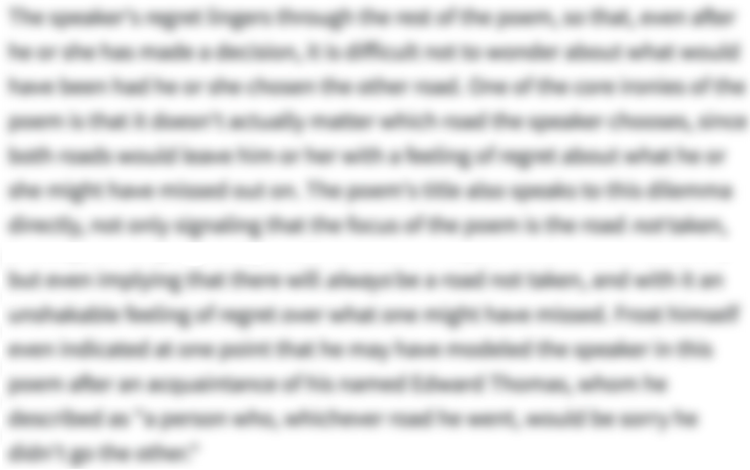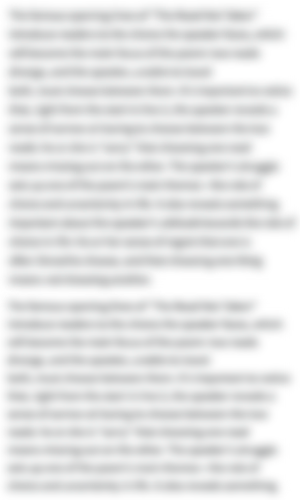The Full Text of “A Psalm of Life”
1 What The Heart Of The Young Man Said To The Psalmist.
2Tell me not, in mournful numbers,
3 Life is but an empty dream!
4For the soul is dead that slumbers,
5 And things are not what they seem.
6Life is real! Life is earnest!
7 And the grave is not its goal;
8Dust thou art, to dust returnest,
9 Was not spoken of the soul.
10Not enjoyment, and not sorrow,
11 Is our destined end or way;
12But to act, that each to-morrow
13 Find us farther than to-day.
14Art is long, and Time is fleeting,
15 And our hearts, though stout and brave,
16Still, like muffled drums, are beating
17 Funeral marches to the grave.
18In the world’s broad field of battle,
19 In the bivouac of Life,
20Be not like dumb, driven cattle!
21 Be a hero in the strife!
22Trust no Future, howe’er pleasant!
23 Let the dead Past bury its dead!
24Act,— act in the living Present!
25 Heart within, and God o’erhead!
26Lives of great men all remind us
27 We can make our lives sublime,
28And, departing, leave behind us
29 Footprints on the sands of time;
30Footprints, that perhaps another,
31 Sailing o’er life’s solemn main,
32A forlorn and shipwrecked brother,
33 Seeing, shall take heart again.
34Let us, then, be up and doing,
35 With a heart for any fate;
36Still achieving, still pursuing,
37 Learn to labor and to wait.
-
“A Psalm of Life” Introduction
-
"A Psalm of Life" was written by the famed New England poet and professor Henry Wadsworth Longfellow. First published in 1838 in the New York literary magazine The Knickerbocker, the poem was inspired by a conversation between Longfellow and a fellow professor. As such, the poem is framed as a dramatic monologue spoken by the "Heart of a Young Man" to a "Psalmist." In the poem, the speaker declares that living in the present is more godly than the kind of austere and restrained life the Psalmist champions. In doing so, the poem captures the spirit of carpe diem, or "seize the day."
-
-
“A Psalm of Life” Summary
-
The subtitle frames the poem as a dramatic monologue spoken by a young man's heart to a composer of Biblical psalms.
First, the speaker begs the psalmist not to sing to him in numerous, sorrowful ways about how life is empty and unreal. In the speaker's opinion, the soul that passively experiences life is essentially dead. Moreover, one shouldn't assume that life is merely how it seems from a certain Christian perspective—that it's just a precursor to eternal life after death.
Life, the speaker demands, is very much real and full of meaning. Life, the speaker adds, is sincere and intense. The meaning of life is not simply death. The Christian saying of "dust to dust," which states that humans come from the earth—or "dust"—and return to dust upon death, only refers to the body and not the soul—so the soul should be full of life.
It is not indulgence or misery that should be humanity's destiny or goal. Rather, the speaker declares, humans should act in such a manner that creates progress day by day.
Acts and products of human creativity last a long time; however, time passes quickly. While human hearts may be strong and courageous, nevertheless they beat like quieted drums within bodies. Ultimately, with each beat, they bring humans closer to their death. Therefore, the songs these hearts produce are like funeral marches.
The speaker then compares the world to a great battlefield. Life, he adds, is like a temporary camp without shelter. Therefore, the speaker commands, don't be like silent cattle who are herded about. Rather, be a hero amidst the conflict of life.
Don't place any certainty, the speaker advises, in the future, no matter how positive the future may seem. Additionally, don't dwell on the past. Rather, the speaker suggests, one should live in the present, wholeheartedly and in plain view of God who watches approvingly above in Heaven.
The way that great men have lived their lives inspires and reminds other individuals to consciously live in a godly and spiritual manner. Moreover, the speaker adds, when these individuals die, they will leave traces of their lives behind.
These remnants and memories of godly and spiritual lives can go on to inspire others who might also be progressing over the great ocean of life. These other individuals might feel miserable, abandoned, and lost in this ocean. However, upon seeing examples of godly and spiritual lives, they will be inspired and saved.
Therefore, all of humanity, the speaker advises, should seize the day. Moreover, they must live life wholeheartedly and fearlessly. While making progress and seeking improvement, humans will learn to struggle and apply themselves, as well as have patience.
-
-
“A Psalm of Life” Themes
-
Living in the Present
In “A Psalm of Life,” the subtitle—What The Heart Of The Young Man Said To The Psalmist—frames the poem as a dramatic monologue. The speaker of the poem is the “Heart of the Young Man,” while his audience is a “Psalmist,” a writer of biblical psalms. The speaker of the poem argues against some of the Psalmist’s religious views, particularly that earthly life is an empty precursor to eternal life in heaven. Rather, the speaker advises, one should seize the day and live in the present—neither dwelling on the past, nor taking the future for granted, nor worrying too much about death. Indeed, the poem radically suggests that living with such a spirit of carpe diem, or "seizing the day," is just as godly as the kind of life that the Psalmist promotes.
The speaker opposes the Psalmist’s idea of earthly life as being less important than eternal life after death. The speaker immediately asks the Psalmist not to preach that “Life is but an empty dream.” The speaker, therefore, does not view life as “empty,” but rather as full of meaning. Additionally, the speaker does not believe that one should experience life passively, as one does in a “dream” or while “slumber[ing].” Indeed, living life in such a way actively damages the “soul” by causing it to be “dead”—i.e. numb and lifeless. Thus, death is not the “goal” of this life. Rather, the goal of this life, the speaker implies, should be life itself and the experience of living. The “soul,” the speaker argues, experiences this earthly life as much as it will experience the afterlife. Therefore, this life is as valuable an experience as the heaven that the Psalmist so champions.
Consequently, the speaker advises another way of living as an alternative to the Psalmist’s short-sighted views. The speaker first establishes that he is not advocating a life of debauchery or penitence. Rather, the speaker takes a more measured view that everyone should “act” in a way that creates progress day by day. The speaker does not preach specific acts or define this progress. Rather, he leaves it open for anyone to be able to accomplish in their own particular manner.
“Time,” and thus life, “is fleeting,” the speaker declares. Therefore, one should seize the day by not acting like “dumb, driven cattle,” but rather as a “hero.” The “cattle” are defined by the fact that they are not only animals who cannot speak (“dumb”), but also followers (“driven”). Thus, the speaker indirectly criticizes thus who blindly follow religious texts, such as psalms written by the Psalmist, without independent reflection of their own. Being a “hero” thus not only requires seizing the day, but also independent reflection.
Fully experiencing and living this earthly life is just as spiritual and godly as—if not more godly than—what the Psalmist advocates. If one “act[s] in the living Present,” the speaker declares, then one is acting with a “Heart within, and God o’erheard.” Therefore, the speaker implies that living in the moment allows humans to fully make use of their hearts, which are given to them by God. Moreover, living with such a carpe diem spirit has full approval of God who is watching “o’erhead.”
Individuals, the speaker announces, have all the agency to “make [their] lives sublime.” The adjective “sublime” is used to describe greatness and transcendence, and traditionally it often has religious connotations. Therefore, the speaker suggests, individuals have the agency to shape their lives in a transcendent and godly manner. Living in this way can set an example for others who are “forlorn” and “shipwrecked” to “take heart again.” Thus, this kind of life can inspire, redeem, and save others; just like the kind of life the Psalmist would encourage.
Living as if life is empty creates a life without soul. On the other hand, living life to the fullest nourishes the soul. Therefore, seizing the day is a more spiritual and soulful act than the one the Psalmist preaches.
- See where this theme is active in the poem.
-
-
Line-by-Line Explanation & Analysis of “A Psalm of Life”
-
Line 1
What The Heart Of The Young Man Said To The Psalmist.
The subtitle of "A Psalm of Life" immediately sets up the poem as a dramatic monologue. A dramatic monologue often takes the form of an argument, in which a speaker tries to persuade an audience of a particular point of view. The speaker of the poem is "The Heart Of The Young Man," while his audience is "The Psalmist," a composer of Biblical psalms. Immediately, the poem establishes a contrast between the secular "Heart of The Young Man" and the more religious "Psalmist."
Furthermore, what is most striking about the subtitle is that while the audience is a human figure ("The Psalmist"), the speaker is not. Longfellow could have easily established the speaker as the "Young Man." A young man might represent youthful passion in contrast to an elderly man who represents a more tempered wisdom. However, the speaker of the poem is the young man's personified "Heart."
Symbolically, the heart often represents emotion and passion, in contrast to the mind, which represents logic and rationality. Therefore—since both a "Young Man" and a "Heart" each represent emotion and passion—the "Heart of the Young Man" is an intensification of this symbolism. Thus, the poem's subtitle prepares readers not only for the figures involved in this dramatic monologue, but also their potential perspectives and arguments.
-
Lines 2-5
Tell me not, in mournful numbers,
Life is but an empty dream!
For the soul is dead that slumbers,
And things are not what they seem.

Unlock all 306 words of this analysis of Lines 2-5 of “A Psalm of Life,” and get the Line-by-Line Analysis for every poem we cover.
Plus so much more...
Get LitCharts A+ -
Lines 6-9
Life is real! Life is earnest!
And the grave is not its goal;
Dust thou art, to dust returnest,
Was not spoken of the soul. -
Lines 10-13
Not enjoyment, and not sorrow,
Is our destined end or way;
But to act, that each to-morrow
Find us farther than to-day. -
Lines 14-17
Art is long, and Time is fleeting,
And our hearts, though stout and brave,
Still, like muffled drums, are beating
Funeral marches to the grave. -
Lines 18-21
In the world’s broad field of battle,
In the bivouac of Life,
Be not like dumb, driven cattle!
Be a hero in the strife! -
Lines 22-25
Trust no Future, howe’er pleasant!
Let the dead Past bury its dead!
Act,— act in the living Present!
Heart within, and God o’erhead! -
Lines 26-29
Lives of great men all remind us
We can make our lives sublime,
And, departing, leave behind us
Footprints on the sands of time; -
Lines 30-33
Footprints, that perhaps another,
Sailing o’er life’s solemn main,
A forlorn and shipwrecked brother,
Seeing, shall take heart again. -
Lines 34-37
Let us, then, be up and doing,
With a heart for any fate;
Still achieving, still pursuing,
Learn to labor and to wait.
-
-
“A Psalm of Life” Symbols
-
The Heart
A heart is traditionally a symbol of human emotions. Often, it stands in contrast to the mind, which is a representation of logic and rationality. In "A Psalm of Life," hearts symbolize the great passions of human beings, including courage, sincerity, and earnestness.
Hearts are explicitly mentioned four times throughout the poem. In line 15-17, the speaker acknowledges the mortality of hearts which are "beating / Funeral marches to the grave." Nevertheless, in all these instances, the speaker is clear that living in the present requires living with "heart." Living with "heart," or living wholeheartedly with a spirit of courage, sincerity, and earnestness, can inspire others to "take heart again." Thus, living with heart enriches the soul and brings individuals closer to a state of the "sublime," and, consequently, closer to a state of grace.
Additionally, the speaker of the poem is described as "The Heart of the Young Man." Here, the young man can be taken as symbolizing vitality and passion. By combining this symbolism with that of a heart, then, the poem ramps up its symbolic intensity from the get-go: affirming that this will be a poem about life, passion, and earnestness.
- See where this symbol appears in the poem.
-
Footprints
Footprints are traces left behind by those who have passed over a particular place. Footprints are usually ephemeral, particular footprints left in the "sands." These footprints in the sands will soon be washed away by the tide or swept away by the wind. In "A Psalm of Life," footprints symbolize the legacy the individuals leave behind after they die.
While footprints may be ephemeral, the footprints in the poem are pressed into the "sands of time" itself—that is, human history. Thus, great people are able to affect the fabric of time, and so contain a kind of power. In other words, people who live great lives leave a lasting mark on history.
Moreover, these footprints can inspire others who are "forlorn and shipwrecked" in life. Those who are "shipwrecked" in the ocean can see footprints on the sand and "take heart again" at the sight of others who have survived and made it to land. Therefore, living in the present has the power to leave behind an inspirational legacy that can affect many others to come.
- See where this symbol appears in the poem.
-
Field of Battle
A battlefield is a site of conflict. As such, it presents a constant threat and tests the courage of those who are present. In "A Psalm of Life," the world and life itself are compared to a "field of battle." Therefore, human individuals exist within the conflict of a battlefield, which symbolizes the challenges of life and the bravery required to overcome them.
In line 20, the speaker acknowledges that individuals can go through this battlefield like "dumb, driven cattle." These individuals who are like "cattle" never face the conflict of life head-on. Rather, they experience the conflict passively, and therefore, the speaker implies, uncourageously. In contrast, individuals can become "a hero in the strife." A "hero" is an inspirational figure who has great courage and vision. In order to live as a hero amidst the battlefield of the world, an individual must live in the present. Only then can individuals truly live and experience the world.
- See where this symbol appears in the poem.
-
-
“A Psalm of Life” Poetic Devices & Figurative Language
-
Personification
Personification occurs in five instances in "A Psalm of Life." In each case, Longfellow uses personification to enhance the imagery of the language and emphasize the depth of emotions in particular lines.
The subtitle of the poem sets up the speaker as the personified "Heart Of The Young Man" in order to stress the passion of the dramatic monologue that will follow. As an archetype, a "Young Man" is a passionate, heroic figure. Therefore, by additionally personifying a "Heart," typically a symbol of strong emotion, the poem doubly stresses the passions of the speaker.
In line 4, the "soul" is also personified as a figure that can live and die: "For the soul is dead that slumbers." Specifically, a sleeping soul is a "dead" one, numb to the experiences of life. Therefore, an individual can gravely harm their soul by passively experiencing, or "slumber[ing]," through life. Consequently, by personifying the soul as a figure that can be harmed or even killed, the speaker heightens the danger of not living in the present.
In line 6 and 7, the speaker also personifies "Life" as a figure with "goal[s]." The "grave," the speaker makes clear, is not a "goal" of life. Rather, life has other goals and deserves the full attention of those who can experience it. One must, the speaker suggests, live life fully in the present. Personification, therefore, stresses the importance and reality of "Life."
In line 15, the speaker again personifies "hearts," now as individuals that are "stout and brave." This further develops the personification of the "Heart Of The Young Man" in the subtitle. By providing hearts with positive character traits of strength and courage, the speaker treats hearts as heroic figures. This personification emphasizes the importance of hearts in individual lives and, particularly, of living with sincerity and emotional depth. At the same time, though, the reader reminded is reminded that hearts "are beating / Funeral marches to the grave." Eventually, all hearts stop beating. Death plays an important role in human attitudes towards life.
In line 23, the "Past" is personified and figuratively brought to life as a figure that is able to "bury its dead." At the same time, the "Past" is described as a "dead Past." Through personification, the speaker acknowledges the powerful presence of the "Past" as similar to a living figure. However, simultaneously, the speaker makes clear the necessity for his audience to let go of the past and move on. As in the previous instances, personification enhances the vivid imagery of the lines while heightening the emotions behind them.
- See where this poetic device appears in the poem.
-
Simile


Unlock all 206 words of this analysis of Simile in “A Psalm of Life,” and get the poetic device analyses for every poem we cover.
Plus so much more...
Get LitCharts A+ -
Metaphor
-
Repetition
-
Caesura
-
Enjambment
-
Alliteration
-
Consonance
-
Assonance
-
Allusion
-
Anaphora
-
-
“A Psalm of Life” Vocabulary
Select any word below to get its definition in the context of the poem. The words are listed in the order in which they appear in the poem.
- Psalmist
- Mournful Numbers
- Slumbers
- Thou
- Art
- Returnest
- Stout
- Muffled
- Bivouac
- Dumb
- Howe'er
- O'erhead
- O'er
- Main
- Forlorn
Psalmist-
One who writes or composes psalms—Biblical songs and prayers.
- See where this vocabulary word appears in the poem.
-
Form, Meter, & Rhyme Scheme of “A Psalm of Life”
-
Form
"A Psalm of Life" is composed of a subtitle and nine quatrains, or four-line stanzas.
The subtitle provides much context for the poem and sets up the quatrains that follow as a dramatic monologue. The subtitle specifies the speaker of the poem as "The Heart Of The Young Man." The subtitle also establishes the speaker's audience, or addressee, as "The Psalmist." Therefore, as a dramatic monologue, the poem is constructed as the speaker's argument intended to persuade the Psalmist that life is not empty.
In "A Psalm of Life," the nine quatrains function very much like a persuasive argument. The quatrains establish the speaker's opposition to the Psalmist's opinion, frame his own argument, provide justification for that argument, elaborate on it, and end on a call to live in the present. The quatrains provide an easily digestible form for this argument.
Furthermore, quatrains in tetrameter, such as these, are often associated with songs—from folk songs to hymns. So, as the speaker provides a rebuttal to the Psalmist, who writes songs for church, this rebuttal also takes the form of a song. After all, the poem is called "A Psalm for Life." It's as if the speaker has written his own psalm that preaches what he believes in: life, courage, and heart.
Finally, rhyming quatrains—as in hymns and folk songs—are a very accessible form for readers, employing quick sentences and often easily memorized phrases. In comparison to something like blank verse, one of the most prestigious forms in English poetry, rhymed quatrains are much more infectious and clear. This gives the poem the feeling that it's directed to a wide audience. The speaker isn't some elevated authority figure, he's one of the people.
-
Meter
"A Psalm of Life" is composed of nine quatrains written in trochaic tetrameter, a pattern consisting of four feet of stressed-unstressed syllables.
Take, for example, the first line of stanza 1:
Tell me | not, in | mournful | numbers
This straightforward use of trochaic tetrameter starts off the poem on a strong note. By leading with stressed syllables, the meter emphasizes the speaker's vigorous argument for living in the present. The powerful pulse of the meter captures the vitality the speaker is talking about.
In each stanza, the second and fourth lines are written in a variation of the meter called catalectic trochaic tetrameter, which just means that there is no unstressed syllable in the last foot. The second line of stanza 1 exemplifies this meter:
Life is | but an | empty | dream!
This adds variation to the poem's music. Longfellow was a poet who put a lot of thought into what meter he used, searching for the most melodious and appropriate effects. Here, the final stressed syllable contrasts with the previous line's unstressed syllable. Whereas an unstressed syllable seems to float out in space, a stressed syllable ends on a note of certainty, emphasizing how sure of his philosophy the speaker is.
Line 6 is one line that breaks the poem's meter. As the first line of stanza 2, line 6 should be written in trochaic tetrameter. It is, however, composed of seven syllables with the following stress pattern:
Life is real! | Life is | earnest!
The break from previously established patterns adds emphasis to this line. Here, the speaker declares his belief in the reality and meaning of mortal life. This belief stands in contrast to the Psalmist's belief in the greater importance of the afterlife. As the Psalmist is a respected religious authority figure, his beliefs are taken at face value by society. Therefore, line 6 not only breaks from previously established metrical patterns, but also breaks from previously established beliefs in society.
Similarly, the choice of trochaic meter also reflects the content of the poem. The falling rhythm of trochaic meter is less common in everyday speech than iambs, which follow the opposite pattern (unstressed-stressed). Therefore, the poem goes against more established rhythms. Similarly, the speaker's argument for living in the present goes against the established authority and beliefs of the Psalmist and society.
-
Rhyme Scheme
In "A Psalm of Life," the rhyme scheme of each quatrain is the same; the first line rhymes with the third line, while the second line rhymes with the fourth. Therefore, the rhyme scheme of the poem is as follows:
ABAB CDCD EFEF GHGH IJIJ KLKL MNMN OPOP QRQR
This is a very intuitive and noticeable pattern. It makes the poem very musical, as if the speaker is writing a song in contrast with the Psalmists "mournful numbers," or sorrowful songs about the emptiness of life. In fact, this poem is called "A Psalm of Life," suggesting that it's supposed to be a psalm, or religious song—one that explains the virtues of living in the present. The simple rhyme helps emphasize that this is a poem meant for a broad audience, just like a church hymn.
Additionally, each stanza employs one "feminine" rhyme and one "masculine" rhyme. A so-called feminine rhyme ends on an unstressed syllable, so the final two syllables of the word have to rhyme. For instance, "fleeting" and "beating" in lines 14 and 16 are a feminine rhyme. Meanwhile, "brave" and "grave" in lines 15 and 17 are a masculine rhyme, because they end on stressed syllables. This alternating pattern increases the musicality of the poem. It also adds a note of finality and determination to the end of each stanza, as these lines end on a stressed rhyme.
Furthermore, none of the quatrains share rhymes with the other quatrains—rhymes don't carry over from one quatrain to the next. Therefore, each rhyme scheme is fully contained within each quatrain, not connected to either past or future quatrains. This is consistent with the speaker's advice to not dwell on the future or the past, but rather to live fully in the present.
-
-
“A Psalm of Life” Speaker
-
The subtitle of "A Psalm of Life" sets up the speaker of the poem as "The Heart Of The Young Man." Therefore, surprisingly enough, the speaker is not a human figure, but rather his personified heart.
In the poem, the heart symbolizes passion and enthusiasm for life. However, even if Longfellow had simply chosen the "Young Man" as the poem's speaker, the poem would have already emphasized the earnest passions of the "Young Man" in comparison to the devout restraint of the "Psalmist." Consequently, Longfellow's choice of the "Heart Of The Young Man" as the speaker doubly emphasizes the passionate emotions of the speaker's point of view.
In the first two lines, the speaker makes clear that he opposes the Psalmist's conception of life as an "empty dream." Indeed, the speaker believes in the exact opposite—that life is "real" and full of meaning. The speaker's frequent use of exclamation marks captures the speaker's earnestness and belief in his own argument.
For the speaker, living in the present is not merely a suggestion, but an urgent directive in order to keep the soul alive. The speaker doesn't act like an authority figure preaching to his audience—as the Psalmist might—but rather includes himself among his audience with the use of words like "our," "us," and "we."
Throughout the poem, the speaker emphasizes his belief in the value of living in the present and in the benefits of this lifestyle for others as well. Indeed, at the end of the poem, the speaker reiterates his directive to live in the present, framing it as a rousing and passionate call to action.
-
-
“A Psalm of Life” Setting
-
The setting of "A Psalm of Life" is the earth, more specifically the word of human affairs. In particular, the poem excludes the afterlife in any form—whether Heaven or Hell. The poem, after all, is concerned with living in the present, in the mortal world.
The poem goes on to describe this world as one of "battle" and conflict. Life, the poem suggests, is only a "bivouac"and thus a temporary camp without permanent shelter. Nevertheless, its impermanence and conflict does not make it less important or worse than the afterlife. Rather, these features add a sense of urgency to the necessity of living in the present and seizing every moment.
The poem also metaphorically describes life as a "solemn main," an expansive ocean that people have often been shipwrecked on. This description, along with imagery of "Footprints on the sands of time," emphasizes how most of the poem's setting is figurative, rather than literal. The images that the speaker conjures up could metaphorically apply to any human life, anywhere in time or space.
-
-
Literary and Historical Context of “A Psalm of Life”
Literary Context
Longfellow first published "A Psalm of Life" in 1838 in the New York literary magazine The Knickerbocker. The following year Longfellow included "A Psalm of Life" in his first collection of poetry, titled Voices of the Night. This debut book, which had a mix of translations and original work, was well received by the public, eventually going on to have multiple printings. Of the original poems in the book, "A Psalm of Life" acquired particular renown.
During this time, Longfellow was heavily influenced by the writings of German author Johann Wolfgang von Goethe, who also firmly believed in living in the present. Longfellow lectured on Goethe as a professor, and also translated him. Longfellow openly admitted the influence of Goethe on his own writings and on "A Psalm of Life" in particular.
Considered one of the greatest American Romantic writers, Longfellow's work highlights characteristics of that artistic movement. "A Psalm of Life," for example is, like other Romantic works, a celebration of the individual and an expression of strong emotions. After all, in the poem, all individuals have the power to leave behind influential legacies and achieve the "sublime." The sublime—the quality of things that are so great or immense they defy human comprehension—was an important idea for the Romantics. They stressed the individual's ability to encounter and express such great things.
Moreover, the sincere passions and frequent exclamations throughout the poem define the speaker's argument and tone in a distinctly Romantic way. Like other Romantic writers such as William Wordsworth or Ralph Waldo Emerson, Longfellow was deeply interested in exploring and championing the feelings of individual life.
Historical Context
The United States went through a period of moral reform in the first half of the 19th century. Issues such as prohibition, slavery, women's rights, and labor conditions were frequently debated in both the private and public sphere. Individuals everywhere were concerned with how to create an ideal, more moral society. Naturally, these ideas of morality were often intertwined with religious beliefs as well.
As such, Longfellow's "A Psalm of Life" joins in that conversation about morality. What is, the poem asks, the best way to live a life? For the speaker, the answer is not to dwell on the past, future, or afterlife, but rather live fully in the present. Living in the present is not simply a better, or more moral, way of living; rather, it is more "sublime," and thus more godly. In this way, Longfellow's poem demonstrates how Romantic ideas about individualism can still be suited to Christian values.
Although "A Psalm of Life" emerges from the concerns of its time, it refrains from referring to specific events or places from contemporary life. The speaker in the poem does not specify or preach particular actions for his readers to take. So, although the poem urges the reader to live in the present, it reads as if it could be spoken from any time or place in human history. This gives the poem the feeling of universality. The speaker leaves the specifics of living in the present up to his audience to define, and leaves plenty of room for future generations to apply the poem to their lives as well.
-
More “A Psalm of Life” Resources
-
External Resources
-
A Biography of Longfellow — A detailed biography of Henry Wadsworth Longfellow, along with more poems.
-
Longfellow at the Maine Historical Society — A valuable resource from the Maine Historical Society, including a full database of Longfellow's poems and biographical information.
-
"A Psalm of Life" Music Video — Listen to and watch a music video interpretation of the poem by the Annie Moses Band.
-
"A Psalm of Life" Read Aloud — Listen to a reading of the entire poem.
-
"Labour and Wait" Art Exhibit — Read about the art exhibition "Labour and Wait," inspired by "A Psalm of Life."
-
"A Psalm of Life" Song Adaptation — Listen to the entire poem sung to music.
-
Leslie Odom Jr.'s Music Album "Mr." and "A Psalm of Life" — Read about a singer—and the original Burr in the musical Hamilton—whose new album titled "Mr." includes a track that incorporates "A Psalm of Life."
-
-
LitCharts on Other Poems by Henry Wadsworth Longfellow
-












